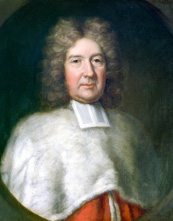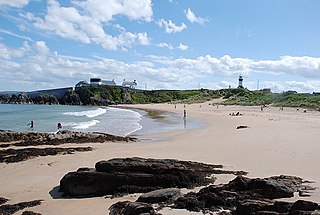James Downham, D.D. was Dean of Armagh from 1667 [1] until his death in 1681. [2]
James Downham, D.D. was Dean of Armagh from 1667 [1] until his death in 1681. [2]
He was the youngest son of Bishop George Downhame, [3] Bishop of Derry from 1616 to 1634, and his first wife, Ann Harrison. He was born when his father was Rector of Great Munden in Hertfordshire, where he was baptised on 24 February 1611. [4] The seat of his education is unknown but he was described as a Bachelor of Divinity in the patent appointing him to the Armagh deanery. [5]
He was admitted to the Prebend of Moville in Inishowen, County Donegal, in September 1634, five months after the death of his father (who had established the prebend in 1629). [6] In 1656 he was the government-salaried Minister at Moville, where the church glebe had been confiscated earlier in the Interregnum [7] and where he may have officiated in previous years. Although many incumbents in other parts of Ulster had been ejected from their livings, the clergy of Inishowen remained relatively safe from purges by extreme Puritans until around 1657. [8]
The Civil Survey of 1654-56 recorded that he held lands belonging to the Bishopric of Derry in the Inishowen parishes of Clonmany and Clonca, and that he claimed to have a 40-years lease of the See's townlands in Clondermot granted by his father. He also held 750 acres of Church land at Clonleigh in Lifford as heir to his recently deceased brother William. [9] Under the will of his stepmother, Dame Margery Roe, proved in 1656, he was to inherit her house, churchlands, chattels and plate. [10]
At the Restoration he obtained the Prebend of Tynan in County Armagh which, until appointed Dean of Armagh, he held in conjunction with the rectory of Derrynoose. In 1661 the Irish House of Lords granted his petition for possession of the glebes which endowed the Tynan and Derrynoose livings and which had been occupied by others during the Commonwealth period. [11] He was instituted as Dean on 10 January 1668 and was also Rector and Vicar of Armagh. [12] In October 1668, at the request of the Archbishop of Armagh, he was appointed to the valuable living of Clonfeacle by Trinity College, Dublin, and thereupon resigned as rector of Derrynoose. [13]
Described in 1668 as "a grave man", he died in June or July 1681 [14] leaving two daughters and coheiresses: Ann, who married Arthur Newburgh (High Sheriff of Tyrone in 1667), and Jane who married Walter Cope and was grandmother of Walter Cope, Bishop of Ferns and Leighlin, 1782–87. [15]

John Bramhall, DD was an Archbishop of Armagh, and an Anglican theologian and apologist. He was a noted controversialist who doggedly defended the English Church from both Puritan and Roman Catholic accusations, as well as the materialism of Thomas Hobbes.
George Downame, otherwise known as George Downham, was an author of influential philosophical and religious works who served as Bishop of Derry during the early years of the Plantation of Ulster. He is said to have been a chaplain to both Elizabeth I and James I.

William John Cardinal Conway was an Irish cardinal of the Roman Catholic Church who served as Archbishop of Armagh and Primate of All Ireland from 1963 until his death, and was elevated to the cardinalate in 1965. He was head of the Catholic Church in Ireland during the reforms of the Second Vatican Council.

Ardstraw is a small village, townland and civil parish in County Tyrone, Northern Ireland, three miles northwest of Newtownstewart. In the 2001 Census it had a population of 222 people.

Lord John George de la Poer Beresford was an Anglican archbishop and Primate.

The Diocese of Armagh is the metropolitan diocese of the ecclesiastical province of Armagh, the Church of Ireland province that covers the northern half (approximately) of the island of Ireland. The diocese mainly covers counties Louth, Tyrone and Armagh, and parts of Down. The diocesan bishop is also the Archbishop of Armagh, the archbishop of the province, and the Primate of All Ireland. The Archbishop has his seat in St Patrick's Cathedral in the town of Armagh.

The Diocese of Derry is a diocese which straddles the international frontier between the Republic of Ireland & Northern Ireland. It is in the ecclesiastical province of Armagh. The diocese was established in the year 1158. The diocese consists of almost fifty parishes and some number of religious congregations have houses in various parts of the diocese.
William Reeves was an Irish antiquarian and the Church of Ireland Bishop of Down, Connor and Dromore from 1886 until his death. He was the last private keeper of the Book of Armagh and at the time of his death was President of the Royal Irish Academy.

Charles Frederick D'Arcy was a Church of Ireland bishop. He was the Bishop of Clogher from 1903 to 1907 when he was translated to become Bishop of Ossory, Ferns and Leighlin before then becoming the Bishop of Down, Connor and Dromore. He was then briefly the Archbishop of Dublin and finally, from 1920 until his death, Archbishop of Armagh. He was also a theologian, author and botanist.
Sir Francis Roe, alias Rooe (c1570-1620), was an English-born infantry officer who served in Ireland during the Nine Years' War, obtained grants of land during the Plantation of Ulster, and became a member of the Parliament of Ireland and mayor of Drogheda.
George Tottenham was Dean of Clogher from 1900 to 1903.

'Michael Ward (1643-1681) was a 17th-century Anglican bishop and academic in Ireland.
James Archibald Hamilton (1748–1815) FRIA, Irish cleric and astronomer, was born in the area of Athlone, Co. Westmeath, Ireland.
Dr. Patrick Sheridan was the Church of Ireland Bishop of Cloyne between 1679 and 1682.
(Abraham) Lockett Ford was an Irish Anglican clergyman.
Charles McHugh was an Irish Roman Catholic prelate and was Bishop of Derry for nineteen years from 1907 - 1926.
Michael Heweton was Archdeacon of Armagh from 1693 to 1700.
Charles Knox was Archdeacon of Armagh from 1814 until his death.

Shrove is a coastal hamlet and townland in Inishowen in the north of County Donegal in the north-west of Ulster, the northern province in Ireland. The hamlet is located a short distance to the north of Greencastle in the north-east of Inishowen, a peninsula on the north coast of Ireland. The name of both the hamlet and the townland is also sometimes written as Shroove, and is sometimes written as Stroove by some government bodies.